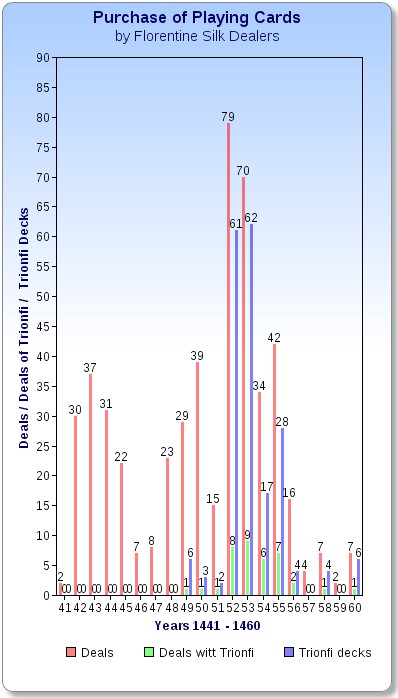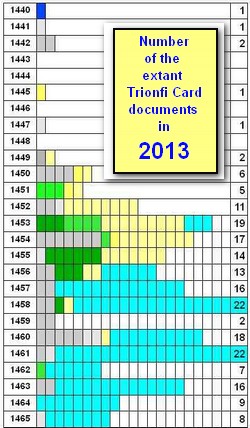Siena 1452, Trionfi Card Production in the time of the Emperor Visit
composed by Lothar Teikemeier, last updated 12.12.2012
|
Italy had euphoric years in 1450-52. The short time schism of the church (1439-49) was solved mid of 1449, a peace between the war parties Milan and Venice followed, shortly disrupted by Francesco Sforza, who on own risk took Milan in February 1450 and ended the Ambrosian republic. The Jubilee year 1450 started and many local festivities followed, accompanied by many foreign pilgrims, who brought money and welfare. December 1450 saw a Florentine statute, in which 4 card games were allowed, likely a consequence of the general good mood of the time, which allowed some tolerance. The Trionfi game had been one of the 4 allowed games. In 1451 Siena (Asinalunga), often influenced by Florentine behavior, followed with own statutes, which also allowed the Trionfi game. Enea Silvio Piccolomini, later Pope II, a man from Siena, negotiated th marriage between the Portuguese princess Eleanore and the Frederick III, king of the Roman Empire, and the wedding was planned to take place in Naples, after Frederick was crowned in Rome as Emperor. The plans for the marriage reached back till 1448, so one might suspect, that the nearness of the dates for the Jubilee year, crowning of the emperor and connected royal marriage in Italy were chosen with conscience and were part of a political plan between new pope Nicolaus V and Frederick III. Some greater liberality in matters of card playing were likely a minor detail in the considerations. In the case of the playing card business of the silk dealers - unluckily we have not much more material to judge it - we've a definite increase of sales (see the graphic to the right) in the considered period. The all time height (as far we see it by the silk dealer business) is reached between 1452-55, with usual playing cards and also with Trionfi decks, which had been very rare in the 1440s, but in these years the consumption "exploded" (in relation to that, what has appeared on the surface for the time before). Still the traded numbers of Trionfi decks were small (a "dozen" in one deal appears variously, in one case 13 decks were traded). It seems, that either the silk dealers had no trust in the new fashion of the Trionfi cards, and wanted to avoid a financial loss, or they had no opportunity to buy more decks (in this period the silk dealer bought from many producers). The decks were still relative "expensive" (the usual lowest price was 9 Soldi, in 2 cases a little less, and this was a price between traders and not for the final user) in comparition to 1-2 Soldi for the lowest priced playing card decks on the market. 12-13 Trionfi decks are low numbers in comparition to 96 decks on the Cambini sale of 1462 and a 309 Triunfi deck note in 1463 (reported by Esch) in the import register of Rome. In 1455 the friendly and modern bookloving Pope Nicolaus III died in spring, and after this followed a Spanish and conservative pope Calixtus III. The card business of the silk dealers slowed down with the death of Nicolaus III and in the observable period it never returned to the values of the sucessful years 1452-1454. Instead we hear from Padova in 1455 about a first attack on the Trionfi cards and in 1456 in Ferrara the jurist Trotti wrote a defense of games and other courtly behavior, in which he takes the Trionfi game as a game of skill and not as a game luck, and cause of this Trionfi cards shouldn't be object of game prohibition. From Germany in 1455 and already before we hear of the engagement of the Franciscan monk Capistranus, which seems to have been the strongest prohibitive tendency ever in Germany against card playing. It's said, that even the playing card industry in Nuremberg (likely the city with the most intensive playing card production in Northern regions) suffered and needed some years to recover. The silk dealer more or less stopped their program of usual playing cards and kept a business with worthful decks till 1460. Then the records end. This fall of the aquire and sale numbers of the silk dealers might have had personal reasons, and not express the general trend of the time, but we have for the moment no better material (we observe no fall of the interest in the material of Ferrara, but Ferrara and the works of Filippo di Marco are "highest class market" and not the "common market", so not really comparable). Calixtus III. died in 1458. The new pope Pius II had a more modern view and especially he had good relation to the growing printing industry. In 1455 he saw the Gutenberg Bibel in Frankfurt and understood, that a new medium had arrived. In his time he cared for the condition, that Sweynheim and Pannartz found their way to Italy. The statistic (right) shows, that 1452/53 were the most significant years for the Silk dealer playing card trade. The Emperor arrived at begin of 1452. He seems to given the deciding signal fo this early Trionfi card success. The years 1449-51 prepared this success (with Jubilee year, with peace after a longer war). The years 1443-1448, dominated by the success of pope Eugen, who had a strong relation to the Franciscans and Franciscans stood for preachings against playing cards, show one single Trionfi deck sold in 1445 for 25 Soldi. The period 1440-42 has 3 clear Trionfi documents and some "special expensive decks" on the market. There was (possibly) a small peak of Trionfi card decks in this short period, which slowed down to nearly nothing in the following years, gaining strength in a lucky period of Italy, finding a new much more massive peak 1452/55, falling back to some passivity. It's expected, that a new peak started arounfd 1462/63, but for the moment there is not enough evidence. |
|
Sources
Sources are mainly taken from our earlier collection at Trionfi.com and the article series of Franco Pratesi.|
Repeated Note: When Ross Caldwell and me in 2003 started to collect Trionfi notes between 1442-1463, we had about 27/28 entries (which I nowadays would count as 31). The major part were the documents of Ferrara, which were collected by Gherardo Ortalli and Adriano Franceschini in the "Prince and the Playing Cards" (1996), after the base laying works of Michael Dummett and Stuart Kaplan around 1980. This collection included 2 notes about Trionfi cards in Florence, found by Franco Pratesi in his earlier work (allowances of the Trionfi game in 1450 and 1463). A graphical representation of this time (with 27 entries) shows the dominance of Ferrarese documents (in black) with a few notes only from other locations (in red; see picture to the right) In the period 2004 till October 2011 it was possible to add 4 further notes (Siena 1452, Padova 1455, Ancona c. 1460 and Valerio Marcello c. 1460), mainly thanks to information given by Thierry Depaulis. Franco Pratesi started his new article series in November 2011. Since then the list has gotten 67 new documents till September 2012 (65 of them found by Franco Pratesi, one, now the oldest of September 1440, by Thierry Depaulis, and another one by Veber Gulinelli, who controlled the earlier work of Franceschini and found an overlooked document) and nearly all are related to Florence or its surrounding. A small book (118 pages) was published around Christmas 2012, Franco Pratesi: "Playing Card Trade in 15th Century Florence" as IPCS Paper No. 7 (ISSN 0305-2133). It contains some of the articles, which before had appeared at this website, those, which treat the early time of 15th century. Thierry Depaulis commented in his foreword: "This book is a landmark in the history of early playing cards in Italy". Well, maybe not the book, but the research is clearly a landmark in various interests. For the collection of early Trionfi notes it somehow means, that we have within the year 2012 about 200 % more data for the period 1440-1462 than mankind had collected in the 200 years before. Added later: In August 2013 the new report of Arnold und Doris Esch: "Aus der Frühgeschichte der Spielkarte. Der Import von carte da giocare und trionfi nach Rom." in Gutenberg Jahrbuch 2013, 88. Jahrgang, p. 41-53, arrived in our redaction. It contains 106 new references to Trionfi decks, which all were found in the customs registers of the city Rome for the period 1453-1465. With this the number of all earlier Trionfi cards records has been doubled and should have reached then c. 210 (from which a few are only considered to be "Trionfi card notes" and don't contain the word "Trionfi" or something similar). *********** I'd started to sort the new Trionfi card documents overview in October 2012. Articles will be possibly changed according improvements in research. |
|



